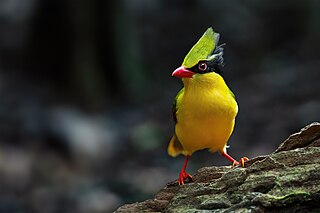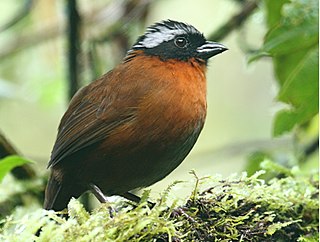
The song thrush is a thrush that breeds across the West Palearctic. It has brown upper-parts and black-spotted cream or buff underparts and has three recognised subspecies. Its distinctive song, which has repeated musical phrases, has frequently been referred to in poetry.

The Eurasian chaffinch, common chaffinch, or simply the chaffinch is a common and widespread small passerine bird in the finch family. The male is brightly coloured with a blue-grey cap and rust-red underparts. The female is more subdued in colouring, but both sexes have two contrasting white wing bars and white sides to the tail. The male bird has a strong voice and sings from exposed perches to attract a mate.

The warbling vireo is a small North American songbird.

The common hill myna, sometimes spelled "mynah" and formerly simply known as the hill myna or myna bird, is the myna most commonly sighted in aviculture, where it is often simply referred to by the latter two names. It is a member of the starling family (Sturnidae), resident in hill regions of South Asia and Southeast Asia. The Sri Lanka hill myna, a former subspecies of G. religiosa, is now generally accepted as a separate species G. ptilogenys. The Enggano hill myna and Nias hill myna are also widely accepted as specifically distinct, and many authors favor treating the southern hill myna from the Nilgiris and elsewhere in the Western Ghats of India as a separate species.

The green peafowl or Indonesian peafowl is a peafowl species native to the tropical forests of Southeast Asia and Indochina. It is the national bird of Myanmar. Formerly common throughout Southeast Asia, only a few isolated populations survive within Cambodia and adjacent areas of Vietnam. It has been listed as endangered on the IUCN Red List since 2009, primarily due to widespread deforestation, agriculture and loss of suitable habitat, severely fragmenting the species' populations and contributing to an overall decline in numbers. Due to their natural beauty, they are still sometimes targeted by the pet trade, feather collectors, and even by hunters for meat. They are a much-desired bird for private and home aviculturists, despite their rather high-maintenance care requirements.

The Indochinese green magpie, also known as the yellow-breasted magpie, is a small colorful bird native to the forests of China all the way to Vietnam.

The red siskin is a small endangered finch.

The red avadavat, red munia or strawberry finch, is a sparrow-sized bird of the family Estrildidae. It is found in the open fields and grasslands of tropical Asia and is popular as a cage bird due to the colourful plumage of the males in their breeding season. It breeds in the Indian Subcontinent in the monsoon season. The species name of amandava and the common name of avadavat are derived from the city of Ahmedabad in Gujarat, India, from where these birds were exported into the pet trade in former times.

The East Asian–Australasian Flyway is one of the world's great flyways of migratory birds. At its northernmost it stretches eastwards from the Taimyr Peninsula in Russia to Alaska. Its southern end encompasses Australia and New Zealand. Between these extremes the flyway covers much of eastern Asia, including China, Japan, Korea, South-East Asia and the western Pacific. The EAAF is home to over 50 million migratory water birds from over 250 different populations, including 32 globally threatened species and 19 near threatened species. It is especially important for the millions of migratory waders or shorebirds that breed in northern Asia and Alaska and spend the non-breeding season in South-East Asia and Australasia.

The Fiji parrotfinch is a species of estrildid finch endemic to Fiji that was formerly considered to be a subspecies of the red-headed parrotfinch. This parrotfinch is a small, mainly green bird with a red head and tail and a stubby dark grey bill. It is found in both forested and open habitats, and has adapted well to man-made environments such as grasslands, pasture and gardens. Pairs have a courtship display in which they fly above the trees in an undulating flight, calling constantly. Breeding birds build a domed grass nest with a side entrance, and lay a clutch normally of four white eggs. Newly hatched chicks are naked and pink, with blue balls at the upper and lower corners of the gape, and black markings inside the mouth; older fledglings resemble the adults, but lack the red head colouring. The Fiji parrotfinch eats seeds, especially of grasses, and also readily feeds on insects and nectar. It forms small flocks of up to six birds after the breeding season.

Wildlife trade refers to the products that are derived from non-domesticated animals or plants usually extracted from their natural environment or raised under controlled conditions. It can involve the trade of living or dead individuals, tissues such as skins, bones or meat, or other products. Legal wildlife trade is regulated by the United Nations' Convention on International Trade in Endangered Species of Wild Fauna and Flora (CITES), which currently has 184 member countries called Parties. Illegal wildlife trade is widespread and constitutes one of the major illegal economic activities, comparable to the traffic of drugs and weapons.

Bird conservation is a field in the science of conservation biology related to threatened birds. Humans have had a profound effect on many bird species. Over one hundred species have gone extinct in historical times, although the most dramatic human-caused extinctions occurred in the Pacific Ocean as humans colonised the islands of Melanesia, Polynesia and Micronesia, during which an estimated 750–1,800 species of birds became extinct. According to Worldwatch Institute, many bird populations are currently declining worldwide, with 1,200 species facing extinction in the next century. The biggest cited reason surrounds habitat loss. Other threats include overhunting, accidental mortality due to structural collisions, long-line fishing bycatch, pollution, competition and predation by pet cats, oil spills and pesticide use and climate change. Governments, along with numerous conservation charities, work to protect birds in various ways, including legislation, preserving and restoring bird habitat, and establishing captive populations for reintroductions.

Vinkensport is a competitive animal sport in which male common chaffinches are made to compete for the highest number of bird calls in an hour. Also called vinkenzetting. It is primarily active in Flanders, the Dutch-speaking region of Belgium.

The straw-headed bulbul is a species of songbird in the bulbul family, Pycnonotidae. It is found from the Malay Peninsula to Borneo. Its natural habitats are subtropical or tropical moist lowland forest, subtropical or tropical mangrove forest, subtropical or tropical moist shrubland, arable land, plantations, and rural gardens. It is threatened by habitat loss and poaching.

The red pileated finch, also known as the red-crested finch, is a species of bird in the family Thraupidae. It is found in Argentina, Bolivia, Brazil, Ecuador, French Guiana, Guyana, Paraguay, Peru, on the eastern side of the Andes. Its natural habitats are subtropical or tropical dry forests, subtropical or tropical moist lowland forests, subtropical or tropical dry shrubland, and heavily degraded former forest. This is a common species, and the International Union for Conservation of Nature has rated its conservation status as "least concern".

The tanager finch is a songbird species. In spite of its common name, it is neither a tanager nor a finch, but a New World bunting, having been moved to that family after variously being placed in either the Emberizidae or the true tanager family Thraupidae. It is the only species in the monotypic genus Oreothraupis. It is found in Colombia and Ecuador, where its natural habitat is subtropical or tropical moist montane forests. It is threatened by habitat loss.

The bay-chested warbling finch is a species of bird in the family Thraupidae. It is endemic to southeastern Brazil.
The Phitsanulok Province of Thailand is home to a plethora of animal and plant species, including a number of endangered, vulnerable and near threatened species. Indigenous animal species include a variety of mammals, crabs, reptiles, amphibians, fish, insects, and over 190 species of birds.

Wildlife smuggling or wildlife trafficking concerns the illegal gathering and trade of endangered species and protected wildlife, including plants and byproducts or products utilizing a species. Research on wildlife smuggling has increased, however, knowledge of the illicit trade remains limited. The differences between international policies and tendencies likely contribute to the extensive estimated range of wildlife smuggling, anywhere from $5-$23 billion, with an additional $67-$193 billion when timber and fish are included. The prolific growth of wildlife smuggling makes it the fourth-largest criminal enterprise globally after drug, firearm, and human trafficking. Products demanded by the trade include but are not limited to ivory, bushmeat, traditional medicine, and exotic pets. China and the United States are the largest buyers in the illegal wildlife trade. It often involves other illegal activities such as tranquilizing animals without proper authorization.

The international trade in parrots is a lucrative enterprise, and forms an important part of the international wildlife trade. As parrots have become increasingly endangered, many countries have placed restrictions on the trade and/or prohibited the trade altogether. Despite the restriction on trade in many countries however, the market still operates both legally and illegally. A big factor that attempts to keep the control in international trade is CITES. The Convention of International Trade in Endangered Species of Wildlife Fauna and Flora was established in 1975, and consists of 184 parties which includes 183 countries along with the European Union. CITES offers three different degrees of protection for around 38,000 species around the world.




















